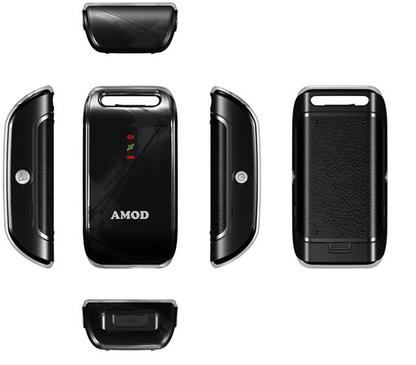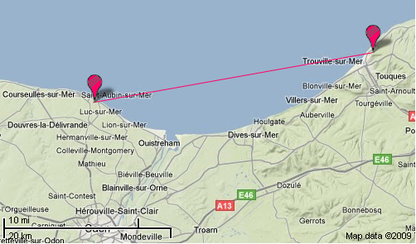Good experience with the Amod AGL 3080 GPS logger
I liked my trusty Sony GPS-CS1 GPS logger, but autonomy of barely more than a good riding day was too short for my taste and the one Hertz sampling rate was too low for satisfactory OpenStreetMap surveying by bicycle or roller-skate, though it was plenty for walking.
After sifting through various reviews and specification sheets, I declared the Amod AGL 3080 the true heir to the Sony GPS-CS1. And after a few months of use I am not disappointed.
This solid little unit is simple to use : normal operation requires a single button. After mounting as USB mass storage with a standard mini-USB cable, a pass trough GPSbabel is all that is needed before the data is ready for consumption. There is also a handy second button for marking waypoints – I use it mostly to record points of interests. The AGL 3080’s SiRF Star III chipset provides satisfactory reception – subjectively much better than the GPS-CS1’s, and the storage capacity is more than you will need for anything up to a transcontinental ride. It uses three AAA batteries, which makes it practical for underway replenishment while making the use of rechargeables possible too. For a walkaround, PocketGPSWorld has a review with detailed pictures.
But what I appreciate most is the ability to configure the output NMEA sentences for the best compromise between autonomy and the richness of the of logged data. 6 logging modes can be by cycled through by pressing the “MARK” button for as much precision or as much battery life as you wish to adjust as you go :
| Mode | LED Status | Output format | Interval (seconds) | Records | Duration (hours) |
| 1 | “Memory Full” on |
GGA/GSA/RMC/VTG | 1 | 260 000 | 72 |
| GSV | 5 | ||||
| 2 | “Memory Full” flash | Only RMC |
1 | 1 040 000 | 288 |
| 3 | “GPS” on | GGA/GSA/RMC/VTG/GSV | 5 | 260 000 | 360 |
| 4 | “Battery Low” on | Only RMC |
5 | 1 040 000 | 1440 |
| 5 | “Battery Low” on | GGA/GSA/RMC/VTG/GSV | 10 | 260 000 | 720 |
| 6 | “Battery Low” flash | Only RMC | 10 | 1 040 000 | 2880 |
The not so good is that the absence of rubber gasket on the battery compartment hints that this device is not waterproof. Like the Sony GPS-CS1 it has been through rain with no apparent problem, but pushing my luck too far will probably result in corrosion.
The ugly is that I have yet to find a way to strap the Amod AGL 3080 securely. It features a strap slot on only one side, making any balanced setup impossible. Supplied Velcro strap can connect it to a carabiner, but the resulting contraption dangles around wherever you attach it – I hate to have dangling things attached to my kit. The Sony GPS-CS1has a pouch that features a convenient Velcro strap to conveniently attach it to a any strap – I use it on top of my backpack’s shoulder straps or on top of my handlebar bag. The Amod AGL 3080 has nothing like that and I have yet to find a good way to mount it on my bicycle – for now, rubber-bands are the least worst option.
But for 70 Euros, it is a bargain if you need a cheap, simple and flexible GPS logger for photography, sports or cartography. Buy it – and then tell me if how you succeeded in mounting it on a bicycle or on a backpack !


